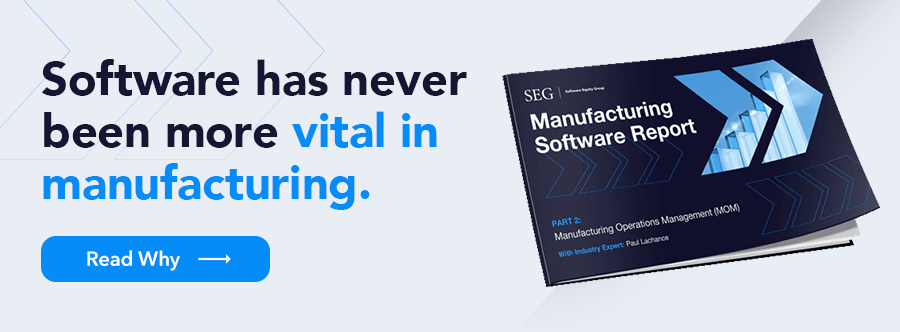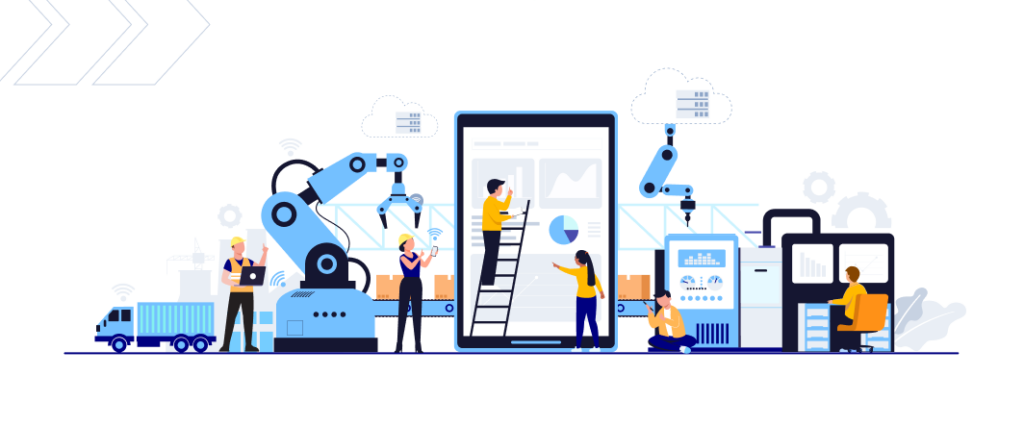- Company
Featured Resource
CLIENT STORYModern Message
To Real Estate
Giant RealPage
- Sectors
Featured Industry Report
EXPERT SERIESManufacturing Software
Report – Part 2
- Research
Featured Resource
FEATURED REPORTThe SEG 2024
Annual SaaS Report
- Tools
Featured Resource
WHITEPAPER20 Factors to Track When Valuing Your
SaaS Company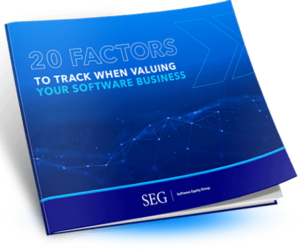
- Blog
How the Digital Transformation Drives M&A Activity in Manufacturing

Software solutions serving the manufacturing industry are more ubiquitous than ever. Prior to the COVID-19 pandemic, digital transformation within manufacturing was already moving forward at a rapid speed. This timeline has only accelerated as the pandemic, economic uncertainty, and subsequent supply chain disruptions have heightened the need for reliable, efficient tech.
In conjunction with industry expert Paul Lachance, Software Equity Group (SEG) recently published a study on the state of manufacturing for 2022. Although focused on SaaS solutions that help automate and streamline the manufacturing process, the report also highlights change occurring within the industry as a whole. In the words of Lachance, manufacturing “need[s] a solution that both understands what the market needs, that core functionality of where the industry is going…and the ability to dazzle in a sales process.”
What is the Digital Transformation Within Manufacturing?
The first part of identifying the many changes affecting the manufacturing industry is intimately understanding the digital transformation already in progress. In general, digital transformations typically refer to the mass adoption of new technologies and automated processes for doing business. In the world of manufacturing, digital transformation largely represents the growth in Industry 4.0 and related technologies. Digital transformation also increases the value proposition of manufacturing services in an increasingly interconnected global economy.
According to IBM, Industry 4.0 is essentially the fourth industrial revolution within the manufacturing space. This means that new workflows and automations are helping products get produced faster, cheaper, and smarter. Cloud computing, analytics dashboards, machine learning, and the Internet of Things technology all are contributing to this trend. Here are just a few ways that Industry 4.0 streamlines manufacturing processes:
- Better data analysis and decision making via robotics and advanced sensors
- Overarching views of supply chains, customer service platforms, and enterprise systems via data aggregation tools
- Real-time visibility into successes and errors within the manufacturing system
- Improved predictive maintenance and less equipment downtime
Ultimately, interconnectivity, automation, machine learning, and real-time data all have a profound effect on manufacturing. SaaS platforms that enable and house these technologies are in more demand than ever before and take on increased importance as other tailwinds impact growth within manufacturing.
As of 2022, several major events and trends are having an outsized impact on the manufacturing industry. Along with pandemic shutdowns, a move toward reshoring has caused more U.S. manufacturers to diversify operations and rely more on domestic suppliers. Federal government policy has recently included many bills and initiatives that encourage home-grown manufacturing. These include the Infrastructure Bill, “Made in America” Executive Order, and the not-yet-passed “America Competes” legislation. With varying provisions, these laws would encourage the U.S. manufacturing space to be less reliant on international producers, which creates huge opportunities for SaaS software providers to support these shifts with purpose built software.
Key Trends Driving M&A Activity in Manufacturing
Combined with the continuing effects of manufacturers moving toward Industry 4.0 technologies, digital solutions to streamline efficiencies and automate processes are in high demand. As part of this growth explosion, investors are eager to get involved with promising technologies that can make impacts within manufacturing.
In combination with the tailwinds affecting manufacturing’s growth, several key trends have emerged that drive M&A activity within the industry. The short list of these effects include:
- The push for manufacturers to upgrade legacy software solutions
- The increasing importance of data and connectivity
- Continued acceleration of Industry 4.0
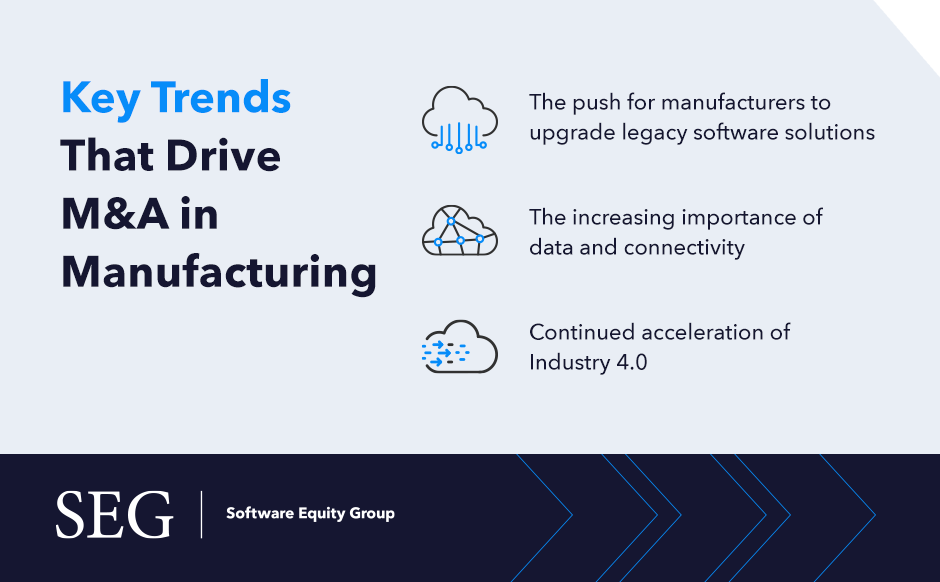
For years, the manufacturing industry has used on-premise solutions to monitor internal production lines. With the exception of large, specialized manufacturers like nuclear power plants and legacy-driven organizations, the majority of companies have started moving toward digital SaaS solutions. SaaS platforms can support enterprise manufacturers, as well as smaller businesses through automation and data-driven scaling. Most solutions integrate with existing legacy platforms so workstreams don’t have to be completely up-ended upon adoption. These next-generation digital alternatives to traditional solutions are a game-changer in the industry, which leads to an increased propensity for acquisitions.
Similarly, data and connectivity allows manufacturers to better optimize and analyze processes. Using intelligent sensors, systems, and assets, companies can take advantage of the latest innovations in AI and machine-learning algorithms to streamline production and increase accuracy. These tools also help reduce delays since they better alert employees to system malfunctions or equipment issues. More data also means more elevated decision making through predictive maintenance schedules, automated system recommendations, and improved customer insights. The cost-saving benefits of these technologies increasingly make the implementation expense worthwhile – a trend that accelerates adoption rates and attracts the interest of savvy investors.
Industry 4.0 continues to be a very real driver for SaaS companies within the manufacturing space. Outside of more well-known technologies like IoT, AI, and ML, the Industry 4.0 revolution also includes additive manufacturing (3D printing), blockchain development, assisted/virtual reality, and cybersecurity among its ranks. For day-to-day operations, mobile-first SaaS solutions have become increasingly critical, particularly for complex platforms that didn’t have easily accessible apps a few short years ago.
In short, these trends in manufacturing tech turbo-charge the value proposition of SaaS companies in the space and drive increased M&A activity. Having an eye on key trends (and how they change over time) is the single best way to capitalize on financial opportunities for SaaS owners and CEOs. It is also a critical strategy for increasing your company’s chances in optimizing M&A outcomes and achieving strategic exit goals.
Understanding the Impact of the Manufacturing Digital Transformation on Employees
For those concerned about the potentially negative impact of all this technological change on workers, there are several reasons to take heart. Rather than replacing human workers with robots, digital transformation has actually ended up empowering on-the-ground employees in ways that weren’t possible before.
Relying on SaaS solutions allows individuals to work in a safer, more efficient environment, which increases employee retention rates and overall business profitability. Faster, adaptable, and more environmentally friendly, many SaaS platforms help workers create higher quality products while receiving real-time customer feedback. Humans very much remain at the center of the manufacturing production process. The biggest difference is that they are now aided by transformative digital technology.
A great example of once-threatening technology that is now ubiquitous is the ATM cash machine. Being able to swipe a debit card and get instant cash has, no doubt, positively impacted the lives of people everywhere. However, the mass adoption of ATMs also resulted in boons for bank tellers. Instead of being relegated to menial, low-skill positions, many bank employees were emancipated from repetitive tasks and able to learn skills needed for higher-paying positions.
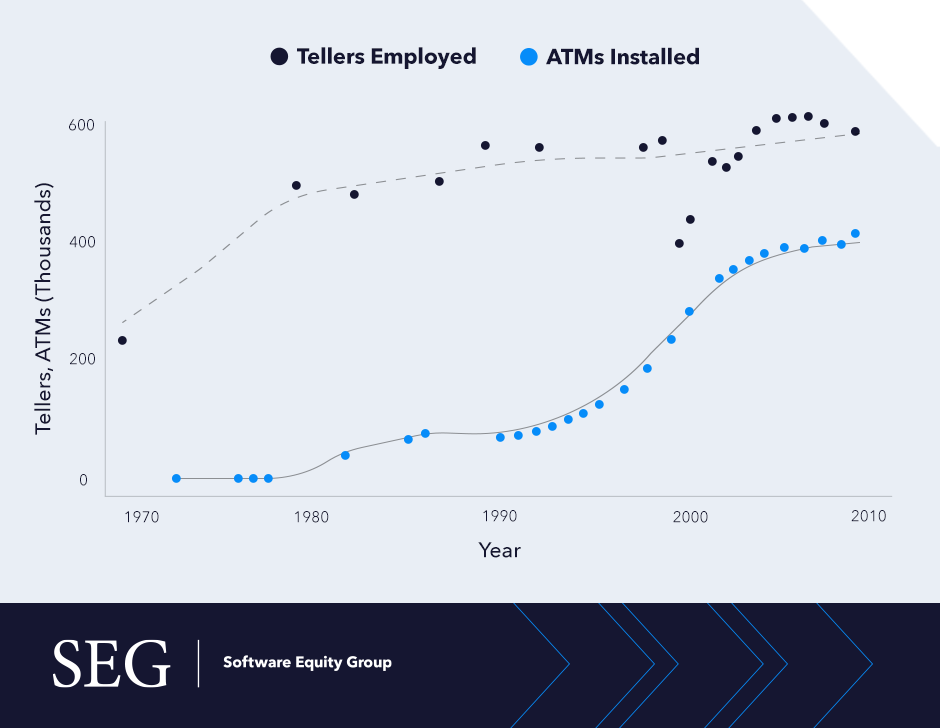
The same trend holds true for manufacturing employees who, understandably, are initially quite fearful of losing positions through increased automation. For business leaders and investors wary about costing workers jobs, the ongoing impact of technology solutions within manufacturing has only promoted growth. Tailwinds that shore up domestic production centers and rapid movement towards Industry 4.0 strengthen existing supply lines and create opportunities for safer and more profitable jobs. No wonder M&A activity is at record highs for SaaS companies within the space.
For more information about how your company can take advantage of prevailing conditions within manufacturing, please download our Manufacturing Software Report or contact us today.

